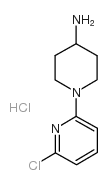SR 57227 hydrochloride

SR 57227 hydrochloride structure
|
Common Name | SR 57227 hydrochloride | ||
|---|---|---|---|---|
| CAS Number | 77145-61-0 | Molecular Weight | 248.15200 | |
| Density | N/A | Boiling Point | 367.6ºC at 760 mmHg | |
| Molecular Formula | C10H15Cl2N3 | Melting Point | N/A | |
| MSDS | Chinese USA | Flash Point | 176.1ºC | |
| Symbol |

GHS06 |
Signal Word | Danger | |
|
The pyramidal neurons in the medial prefrontal cortex show decreased response to 5-hydroxytryptamine-3 receptor stimulation in a rodent model of Parkinson's disease.
Brain Res. 1384 , 69-79, (2011) In the present study, effect of SR 57227A, a selective 5-hydroxytryptamine-3 (5-HT(3)) receptor agonist, on the firing activity of pyramidal neurons in the medial prefrontal cortex (mPFC) was studied in normal rats and rats with 6-hydroxydopamine lesions of t... |
|
|
Discriminative stimulus effects of 5.6 mg/kg pregnanolone in DBA/2J and C57BL/6J inbred mice.
Alcohol 37(1) , 35-45, (2005) Neurosteroids represent a class of endogenous compounds that exert rapid, nongenomic effects through neurotransmitter receptor systems such as gamma-aminobutyric acid(A) (GABA(A)). Two neurosteroids, allopregnanolone (3alpha-hydroxy-5alpha-pregnan-20-one) and... |
|
|
SR 57227A: a potent and selective agonist at central and peripheral 5-HT3 receptors in vitro and in vivo.
Eur. J. Pharmacol. 237 , 299, (1993) SR 57227A (4-amino-(6-chloro-2-pyridyl)-1 piperidine hydrochloride) is a novel compound with high affinity and selectivity for the 5-HT3 receptor. The compound had affinities (IC50) varying between 2.8 and 250 nM for 5-HT3 receptor binding sites in rat cortic... |
|
|
Antidepressant-like effects of SR 57227A, a 5-HT3 receptor agonist, in rodents.
J. Neural Transm. Gen. Sect. 102(2) , 83-90, (1995) We have investigated the effect of SR 57227A, a selective 5-HT3 receptor agonist which crosses the blood brain barrier, on three rodent models in which antidepressants are active. In the forced swimming test, SR 57227A dose-dependently reduced the duration of... |
|
|
Inhibition of NMDA-receptor mediated response in the rat medial prefrontal cortical pyramidal cells by the 5-HT3 receptor agonist SR 57227A and 5-HT: intracellular studies.
Synapse 29(3) , 257-68, (1998) The techniques of intracellular recording and single-electrode voltage-clamp were used to study the effect of serotonin (5-HT) and the selective 5-HT3 receptor agonist SR 57227A on N-methyl-D-aspartic acid (NMDA)-evoked responses in pyramidal cells of the rat... |
|
|
Transient expression of functional serotonin 5-HT3 receptors by glutamatergic granule cells in the early postnatal mouse cerebellum.
J. Physiol. 589(Pt 20) , 4837-46, (2011) The serotonin 5-HT(3) receptor is the only ligand-gated ion channel activated by serotonin and is expressed by GABAergic interneurons in many brain regions, including the cortex, amygdala and hippocampus. Furthermore, 5-HT(3) receptors are expressed by glutam... |
|
|
Individual differences in the sensitivity to serotonergic drugs: a pharmacobehavioural approach using rats selected on the basis of their response to novelty.
Psychopharmacology 205(3) , 441-55, (2009) The mechanisms underlying individual differences in the response to serotonergic drugs are poorly understood. Rat studies may contribute to our knowledge of the neuronal substrates that underlie these individual differences.A pharmacobehavioural study was per... |
|
|
Ionotropic 5-HT3 receptor agonist-induced motor responses in the hindlimbs of paraplegic mice.
J. Neurophysiol. 94(5) , 3397-405, (2005) Centrally expressed 5-HT3 receptors (5-HTR3) are well known for their role in wakefulness, cognition, and nociception. However, clear evidence of their participation in motor control is still lacking despite specific 5-HTR3 expression in hindlimb motor areas ... |
|
|
Serotonin3 receptor agonists attenuate glutamate-induced firing in rat hippocampal CA1 pyramidal cells.
Neuropharmacology 33(3-4) , 483-91, (1994) The techniques of extracellular single cell recording and microiontophoresis were used to study the effect of 5-HT3 receptor agonists on glutamate-activated firing of CA1 hippocampal pyramidal cells. Iontophoretic application of 5-HT3 receptor agonists 2-meth... |
|
|
Mode of action of gingerols and shogaols on 5-HT3 receptors: binding studies, cation uptake by the receptor channel and contraction of isolated guinea-pig ileum.
Eur. J. Pharmacol. 530(1-2) , 136-43, (2006) Ginger (rhizomes of Zingiber officinale) has been shown to exert potent anti-emetic properties, but its mode of action has not yet been elucidated. Among its active constituents, [6]-, [8]- and [10]-gingerol as well as [6]-shogaol were shown in different in v... |